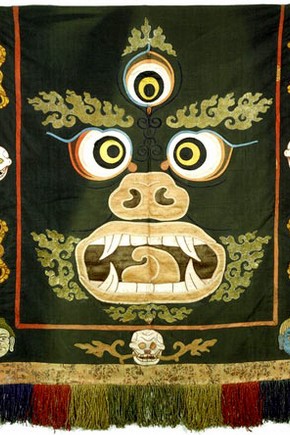Conservation Journal
July 1994 Issue 12
Conservation of a pang khebs
In 1905 the South Kensington Art Museum, as the V&A was then called, was given a portion of a masker's costume from the Himalayan district of Sikkim. The gift consisted of a robe, collar, apron (pang khebs), hat and boots, reputedly worn by a Sikkimese lama in 'The Mystery Play' (Tag-mar-ch'am).
The costume showed heavy Tibetan influence, particularly the apron where the decoration was achieved by applique work: a typically Tibetan technique used mainly for religious textiles. Aprons of this kind are often seen in early photographs of Tibet showing the 'Black Hat' dance performed as part of the New Year celebrations. The designs are usually similar to the one being discussed here, only varying slightly in colour but always worked using the same applique technique. Tibetan applique work has, to date, been little researched. It does however warrant study because it uses techniques and materials intrinsic to Tibet, which even today in the late twentieth century is still relatively inaccessible to the general Western public.
The main body of the apron (measuring 86 cm high x 77.5 cm wide) is simply constructed from three pieces of silk and cotton union twill. The design portrays a khro rgyal, a wrathful protector of religion, surrounded by: sacred thunderbolts (dorje) symbolically depicting the indestructible aspect of the enlightened mind; heads of ghouls (tur); and fierce deities (t'o-wo), these latter two reminding the viewer of the transience of existence (Fig.1).
Like patchwork and applique textiles in Europe, Tibetan applique also appears to have used left-over pieces of fabric. Numerous weave types were used on this particular apron, ranging from plain weave, twill and satin to damask and brocade utilising silvered paper lamellas.1 Black ink outlines were visible on many of the motifs indicating how the design would have been mapped out prior to cutting. Raw edges were 'stopped' with a paste and these edges were then either turned underneath or concealed with bias cut strips sewn over the top. The khro rgyal's three eyes were interlined with a thick yellow paper to give them extra body and stiffness. The fire-like whiskers and eyebrows were of gilded leather which proved to be alum tawed with a varnished silver surface.2 The other interesting discovery was the use of Yak (Bos grunniens) hair in the gimp (a thick cord like thread) outlining many of the design elements.3
Structurally the apron was sound. However damage had been sustained probably through wear when the dancer, in a state of semi-trance, would have whirled around raising and lowering his arms, thus brushing his voluminous sleeves against his apron and resulting in lifting and delamination of the silvered paper lamellas in the outer border. One corner of this border was particularly damaged, caused by stress and abrasion received when the apron was secured around the wearer's waist. Folding the apron in half for storage had also caused a strong disfiguring crease through the central eye (accentuated by the thick paper) and flame whiskers below the demon's mouth.
A fairly passive approach was taken over the conservation mainly because of the mixed media used in the construction of the apron. Lessening the severe crease was achieved by cold poultice. The textile is placed over damp cloths and a dry cloth is used as an isolating layer. A sheet of polythene placed on top allows the textile to relax in the resulting humid conditions. The textile is then pinned under tension over the cloths and left until they are dry.
The outer border was treated by using 5% Klucel G (hydroxypropyl cellulose) in ethanol to lay both lifting and delaminating lamellas back into position. A non-aqueous adhesive was chosen to reduce the likelihood of any possible staining and weakening of the paper and for speed of drying. Although the paper was originally woven into the fabric, the more common conservation technique of stitching was not appropriate for this treatment and, in order to stabilise the lamellas, an adhesive treatment was used. Any movement after adhesion would again result in lifting of the lamellas; therefore the chosen method of display needed to be integral with the conservation giving permanent support to the entire apron. This entailed mounting it onto a flat padded board which to a certain extent has diminished the apron's visual impact now it is viewed out of context. However I hope that at some future date the remaining items of the ensemble will be conserved and the apron's static display re-examined.
References
1 A lamella is a flat strip of precious or base metal or of gilt or silver membrane, leather or paper used for yarn. It may be used flat or wound around a core.
2 Analysis by Leather Conservation Centre, Northampton.
3 Analysis by Jo Darrah, Conservation Science Group, V&A.
